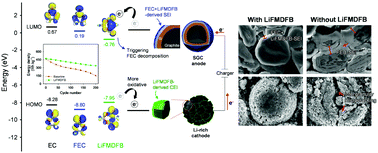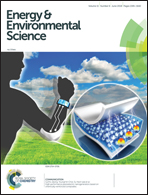Unsymmetrical fluorinated malonatoborate as an amphoteric additive for high-energy-density lithium-ion batteries†
Abstract
High-capacity Si-embedded anodes and Li-rich cathodes are considered key compartments for post lithium-ion batteries with high energy densities. However, the significant volume changes of Si and the irreversible phase transformation of Li-rich cathodes prevent their practical application. Here we report lithium fluoromalonato(difluoro)borate (LiFMDFB) as an unusual dual-function additive to resolve these structural instability issues of the electrodes. This molecularly engineered borate additive protects the Li-rich cathode by generating a stable cathode electrolyte interphase (CEI) while simultaneously tuning the fluoroethylene carbonate (FEC)-oriented solid electrolyte interphase (SEI) on the Si–graphite composite (SGC) anode. The complementary electrolyte design utilizing both LiFMDFB and FEC exhibited an improved capacity retention of 85%, a high Coulombic efficiency of ∼99.5%, and an excellent energy density of ∼400 W h kg−1 in Li-rich/SGC full cells at a practical mass loading after 100 cycles. This dual-function additive approach offers a way to develop electrolyte additives to build a more favorable SEI for high-capacity electrodes.



 Please wait while we load your content...
Please wait while we load your content...